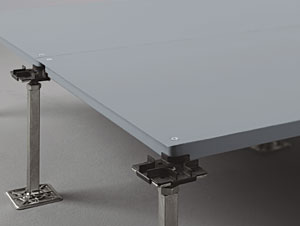Raised Access Floors: The Foundation of Flexibility and Efficiency
Access Floor Components: Access floors consist of two primary components: the floor panel itself, which comes in various types and surfaces, and the pedestal supports, which also come in various types and adjustment options. Both are described further below:
|
• Floor Panels: Panels are fairly standardized, regardless of manufacturer, and have the following attributes:
Sizes: Generally two feet by two feet for full-height access floors.
Materials: Most panels have a steel exterior with either a cement fill or wood core. A typical cement-filled panel has a top and a bottom steel pan. The bottom pan is comprised of a series of domes for structural efficiency. The panel works like a miniature waffle-slab, which creates the most efficient strength to material ratio.
Surface options: The most common finish option is to use painted panels, particularly if the floor will be carpeted. High pressure laminate (HPL) panels are also available and dissipate static, preventing damage to sensitive electronic equipment when used in computer environments.
HVAC floor diffusers: When the access floor includes an underfloor HVAC system, adjustable air diffusers can be placed in the floor panels to allow supply air from the underfloor plenum to enter the workspace. In this manner, occupants may readily control airflow volume and direction through the adjustable portions of the diffusers. More diffusers allow for more individual control within space.
• Pedestal Supports: Pedestal supports are the pieces that hold the floor panels and raise them up above the structural floor of the building. They are typically made of galvanized steel and include a threaded head to allow for specific height adjustment and floor leveling.
Standard height pedestals: Standard sizes allow for finished floor heights (FFH) between six inches and 24 inches in one-inch increments. The addition of a threaded rod allows for final adjustments in one-eighth-inch increments to ensure a level floor. Typical applications are up to 24 inches, but some applications will go even higher to accommodate additional utility routing.
Low-profile pedestals: They are typically used in applications where there are building structure floor-to-ceiling height restrictions or where a facility is looking to more easily upgrade its wiring and technology infrastructure. Typically, these pedestals allow for finished floor heights (FFH) between two and one-half inches and five inches. However, it should be noted that, since typical panels are one and one-half inches thick, the actual clearance can be less than one inch on a two and one-half inch FFH due to uneven floors. This can add significant technical challenges and coordination issues in routing utilities. In these cases, a true fixed-height low-profile floor may be a better solution.
Other Options: Additional types of pedestal supports are available to address specific building needs. For example, ramp type pedestals use a swivel head to allow for an adjustable slope or a 1:12 ramp slope for ADA compliance. Similarly, seismic pedestals have larger bases and thicker steel walls to withstand lateral forces. Usually adhesive attachment will be adequate to comply with many seismic code requirements. Occasionally, in higher seismic zones, fasteners and stringers may need to be applied.
Specification and Design Considerations: Based on the information described above, some relevant details are important when designing or specifying access floor systems:
Finished Floor Height (FFH) Requirements: With the various types and adjustment options of access floors, different finished floor height requirements can be achieved.
Five-inch minimum FFH is needed for adequate clearance to route wires.
Eight-inch minimum FFH is needed for pressurized plenums to distribute underfloor HVAC systems in small floor plans.
Twelve-inch minimum FFH is needed for most underfloor air distribution (UFAD) systems and horizontal wire management.










